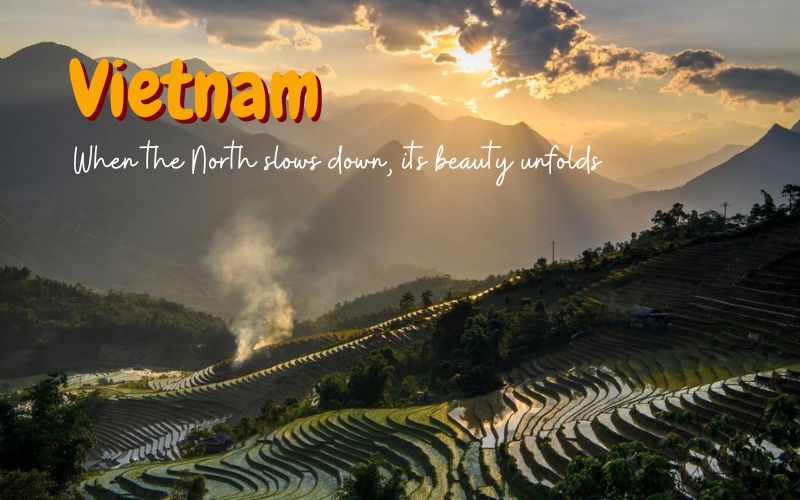
Winter in Northern Vietnam typically begins in late October or early November and lasts until February. The coldest period usually falls between December and January, especially in mountainous areas like Sapa and Ha Giang.
Compared to the South, which has only two dry and rainy seasons with warm average temperatures, the North of Vietnam experiences a more diverse year with four distinct seasons. The biggest difference is winter in Northern Vietnam.
In the North, winter often arrives with monsoons bringing distinct cold air. This is also the time to feel a unique beauty of the land and sky. When the green of the fields gives way to white mist, when a hot bowl of pho becomes a warm comfort and when every street is bustling with the breath of festivals, that is when winter brings truly different experiences. Let’s explore the beauty of the North in the cold winter days through this Vietnam winter travel guide.
When Does Winter in Northern Vietnam Begin?
Winter in Northern Vietnam usually starts from late October to early November, but to feel the cold air clearly, you have to wait until around the end of November, and it will last until around February of the following year.
What’s the Weather Like in Northern Vietnam During Winter?
The northern Vietnam weather in winter can vary significantly depending on the region. This is the time when the climate changes most clearly in the year, with average temperatures ranging from 10–20°C. In the northernmost provinces such as Sapa, Ha Giang or Lang Son, the temperature can drop below 0°C, and in some years there is even frost or snow which is a rare sight in tropical Asia.
Northern Vietnam weather in winter is often cold and foggy, especially in the early morning and late afternoon. Some days from late winter into early spring, there may be light drizzle. Although the cooler temperature may bring some laziness, winter has so many fun things to do and delicious seasonal foods to try.
Top Destinations to Experience Winter in Northern Vietnam
| Destination | Average temperature (°C) | Best time to Visit | Highlights | Ideal For |
| Sapa | 0-10°C | Dec-Feb | Possible frost and snow
Fansipan cable car, ethnic villages, salmon hotpot |
Snow-seekers, trekkers, nature lovers |
| Ha Giang | 5-15°C | Nov-Dec | Ma Pi Leng pass, buckwheat flower season, Dong Van Ancient town | Adventure travelers, motorbike tours, photographers |
| Moc Chau | 10-18°C | Dec-Feb | Plum and peach blossom season, tea hills, pine forest, local milk products | Flower hunters, couples, weekend trips |
| Tam Dao | 10-18°C | Nov-Feb | Misty mountain town near Hanoi, stone church, Bac waterfall | Short escapes, relaxation, family trips |
| Ha Noi | 12-18°C | Dec-Feb | Peaceful winter vibe, street food, Tet preparations | Culture seekers, foodies, photographers |
| Mai Chau | 12-20°C | Nov-Feb | Thai stilt houses, rice fields, Lac & Pom Coong villages | Cultural experiences, cycling, slow travel |
| Ninh Binh | 15-20°C | Dec-Feb | Trang An boat trip, Bai Dinh Pagada, Van Long Lagoon | Short winter trips, sightseeing, photography |
Sapa – A Winter Wonderland with Frost and Snow
Sapa is one of the most popular destinations for winter trekking in Vietnam. From late December to mid-February, the temperature will fall to 0°C and there will be days when there is frost or even light snow in some of the high mountain areas like Fansipan, O Quy Ho or Hang Da village. This phenomenon is quite rare in Vietnam, so it always attracts many domestic and foreign tourists.
This is a great place for winter trekking in Vietnam, especially along ethnic villages like Cat Cat, Ta Van or Ta Phin. You can also take the cable car to Fansipan Peak and admire the Hoang Lien Son range in a sea of clouds. Afterward, enjoy a Dao herbal bath to warm up after the cold.
Winter cuisine in Sapa is also worth trying. Visitors can enjoy salmon hotpot, thang co, grilled meat, or sip apple wine in the chilly air.
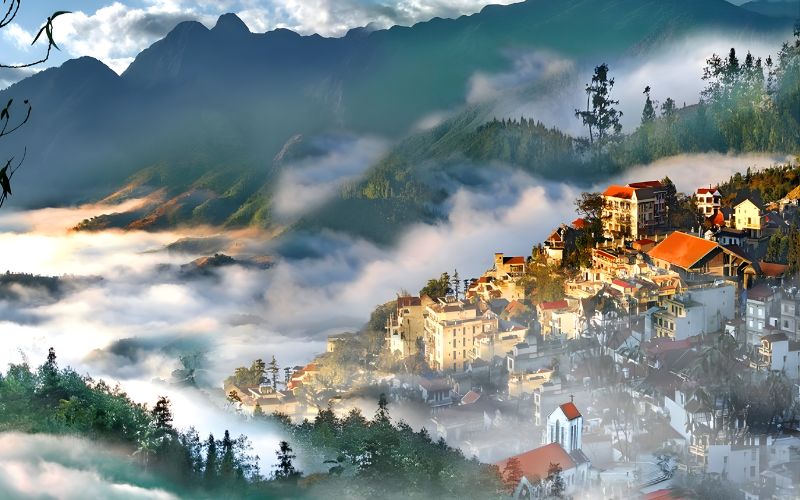
Sapa
>>> Discover the charm of winter in Northern Vietnam with the Sapa Tour 3 Days 4 Nights, a perfect short trip for those seeking scenic views and authentic highland experiences.
Ha Giang – The Rugged Beauty of the Far North
Ha Giang is located in the far north of Vietnam, famous for its majestic landscapes and spectacular mountain passes. Winters here are often cold, with average temperatures ranging from 5 to 15 degrees Celsius, and thick fog covers the valleys and mountain slopes in the morning.
Visitors to Ha Giang can conquer Ma Pi Leng Pass, one of the most beautiful mountain passes in Vietnam, where the Nho Que River meanders between limestone mountains. Dong Van Ancient Town is also an interesting stop to enjoy coffee, visit the weekend market and explore ancient stone architecture. In addition, Lung Cu Flagpole – the northernmost point of Vietnam is where you can clearly feel the beauty of Vietnam’s border region from the top of the high mountain
From late November to early December, Ha Giang plateau enters the buckwheat flower season. The purple-pink flower fields stretching between the rocky mountains create a beautiful scene, very popular with international tourists.
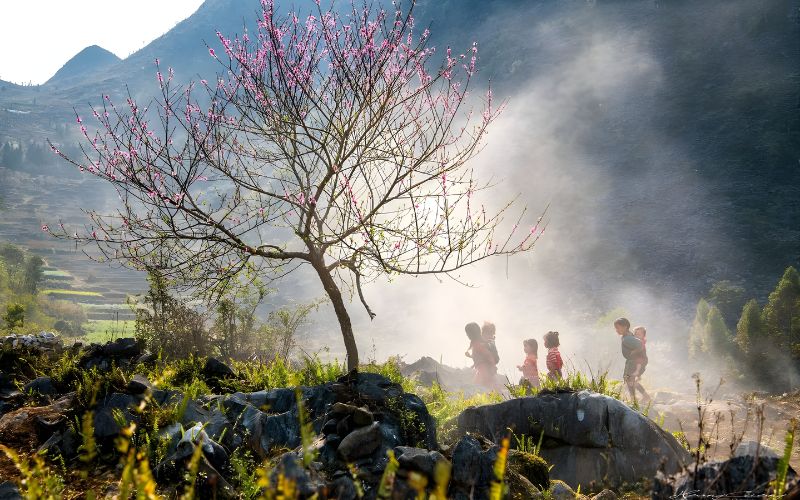
Ha Giang
>>> For those who wish to admire the majestic mountain scenery and experience winter trekking in Vietnam, especially in the far North, the Incredible Panorama of Ha Giang 4 Days 3 Nights tour is a perfect choice to discover the true beauty of Ha Giang in the cold season.
Moc Chau – Where Flowers Bloom in the Cold
Moc Chau is another choice for those who want to experience the chilly winter air in Northern Vietnam. Winter temperatures usually range from 10 to 18 degrees Celsius. There is fog in the morning and light sunshine at noon, very pleasant.
From December to February, Moc Chau enters the season of plum and peach blossoms blooming, the pure white and gentle pink colors blending with the mist and majestic scenery of the mountains of Vietnam. The valleys in Na Ka, Pa Phach or Phieng Canh villages become brilliant with white and pink colors. In addition, visitors can visit Trai Tim tea hill, the symbol of Moc Chau, to take photos and enjoy tea. Other attractions such as Thai Dai Yem, Ban Ang pine forest or Bach Long glass bridge are also worth exploring.
Moc Chau cuisine has a strong highland flavor with outstanding dishes such as fried veal, grilled stream fish, fresh milk and handmade cheese.
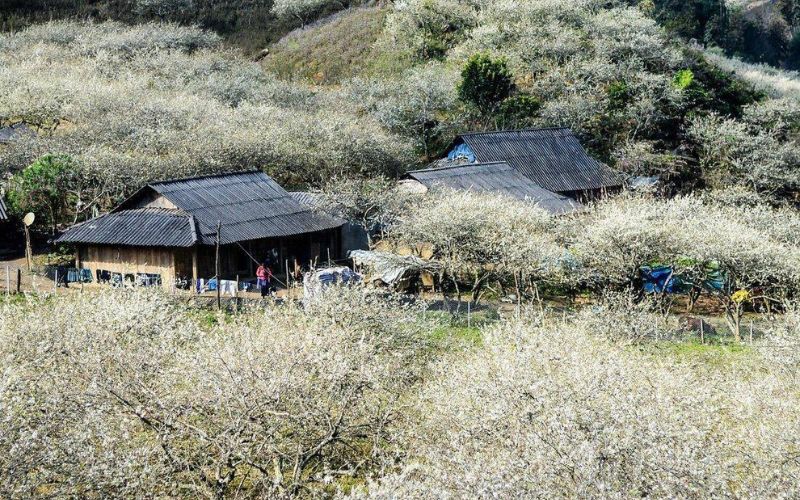
Moc Chau
>>> Check out complete Moc Chau Travel Guide, a perfect addition to your Vietnam winter travel guide for an unforgettable experience in the highlands of northern Vietnam.
Tam Dao – The Misty Town Near Hanoi
Tam Dao is located about 80km from Hanoi, famous for its cool climate all year round. In winter, this small town is often covered in mist, with undulating mountains looming.
Attractions include the ancient stone church, Bac waterfall, Ba Chua Thuong Ngan temple and the central square. The cool evening air is perfect for enjoying drinks or hot pot with friends.

Tam Dao
Ha Noi – The Soul of Northern Winter
Winter in Hanoi brings a very different atmosphere compared to the rest of the year. The average temperature is from 12 to 18 degrees Celsius, sometimes with cold winds and light drizzle. This is the ideal time to feel the ancient and peaceful features of the capital
In the morning, visitors can take a walk around Hoan Kiem Lake or Phan Dinh Phung Street where rows of ancient trees shade the mist. Cold-season dishes are a special highlight of Hanoi, from Pho, Bun Thang, rib porridge to grilled corn and sweet potato or egg coffee.
From January to February, the atmosphere of preparing for Tet spreads throughout the city. Streets like Hang Ma and Quang Ba flower market are brightly decorated, very suitable for walking and taking pictures of the simple beauty of Hanoi. For any Vietnam winter travel guide, Hanoi is a must-visit.

Ha Noi
>>> Learn more about the capital’s timeless beauty in the Hanoi History & Culture article, a must-read for anyone looking to enrich their Vietnam winter travel guide.
Mai Chau – A Peaceful Valley Escape
Mai Chau is an ideal destination for those who want to escape the hustle and bustle of the city without having to travel too far. Located about 3 hours by car from Hanoi, this place has an ideal climate to enjoy a beautiful winter.
You can stay in a traditional Thai stilt house, watch the busy rice fields and experience activities such as cycling through Lac village, Pom Coong village or watching traditional xoe dance in the evening.
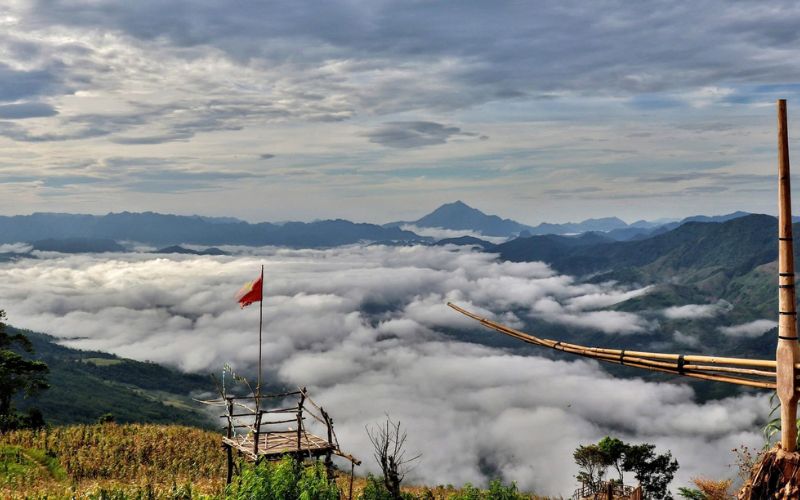
Mai Chau
Ninh Binh – Serenity in the Winter Mist
About 2 hours by car from Hanoi, Ninh Binh is the perfect destination for short trips in winter. The weather here is cool and chilly, with temperatures ranging from 15 to 20 degrees Celsius. There is often light fog in the morning, creating a hazy scene that is very suitable for those who love photography.
Visitors can take a boat to visit Trang An which is one of World Heritage Sites of Vietnam or Tam Coc, admire the steep limestone cliffs and the amazing cave system. In addition, Bai Dinh Pagoda and Van Long Lagoon are other highlights, where you can see migratory birds coming to avoid the cold.

Ninh Binh
>>> Explore a serene escape with the Ninh Binh 2 Days 1 Night trip which is ideal for those wanting a gentle taste of winter in Northern Vietnam and a memorable short-break adventure.
Essential Travel Tips for Winter in Northern Vietnam

Tips for traveling in Northern Vietnam in winter
What to Pack
The weather in Northern Vietnam in winter varies depending on the terrain. In the plains like Hanoi or Ninh Binh, the temperature usually ranges from 12 to 20 degrees Celsius. However, in the highlands like Sapa or Ha Giang, the temperature can drop below 5 degrees Celsius, even freezing.
So you should prepare:
- Thick coat or warm down jacket
- Thermal clothing, scarves, woolen hats and gloves
- Sports shoes or hiking shoes with good grip, especially if you plan to go hiking
- Cold medicine, balm or heat patches, as the temperature at night can be much colder than during the day
If you are used to the harsh winters of the northernmost countries, the climate in Vietnam will be more pleasant, but the humidity can make you feel colder than the actual number.
Getting Around
Transportation in the North is quite convenient. Tourists can fly to Hanoi, then continue by bus, train or rent a private car to travel to tourist destinations such as Sa Pa, Ha Giang, …
Some notes when traveling:
- If going to mountainous areas, you should choose a car with a local driver who is familiar with the road, especially in foggy or slippery conditions
- If you want to be flexible with your schedule, you can rent a motorbike, but you should avoid driving at night or when there is heavy fog.
- For short trips from Hanoi, going on a group tour or a private tourist car is a safe and time-saving choice.
Accommodation Tips
This is also the peak time for tourism in Vietnam, prices are often higher than in the low season, especially around the end of January and the beginning of February because this is the time close to the Lunar New Year, so plan early to find homestays or hotels at reasonable prices.
Winter cuisine to try
Northern Vietnamese cuisine in the cold season is especially attractive thanks to delicious dishes with lots of spices to help keep the body warm.
Some dishes to try:
- Pho bo, bun thang, porridge with ribs in Hanoi
- Salmon hotpot, grilled meat, thang co in Sapa
- Be chap, soy sauce, Moc Chau sweet soup in Son La
- Spicy goat meat rice in Ninh Binh
- Don’t forget to try hot cups of coffee or highland corn wine, these are two very popular drinks in the cold season in the North.
Health & Safety Reminders
- Cold, humid and foggy climate can make visitors susceptible to colds, especially when changing altitude quickly
- Keep your neck and chest warm, avoid wearing wet clothes when going out in the cold
- Drink enough water and limit strong alcohol when traveling in mountainous areas
- If climbing or trekking, you should have a guide and bring water and snacks
- Some mountainous areas have dense fog or narrow roads, so avoid driving at night
Winter in Northern Vietnam is the time for visitors to feel a different Vietnam – quiet, deep and rich in identity in the clearest way. From the misty valleys of Sa Pa, the majestic passes of Ha Giang, to the ancient space of Hanoi or the serenity of Ninh Binh, each place has its own unique characteristics when the weather turns cold. This is also an opportunity to enjoy hot dishes, learn about highland life and explore nature in its most pristine beauty.
If you are looking for a different journey, not too crowded, not noisy but still full of memorable experiences, please contact us to start a trip to the North of Vietnam in winter, this will definitely be a choice worth considering. A short trip is enough for you to feel the breath of the mountains and forests, the warmth of the cuisine and the friendliness of the people here.
Read More:



